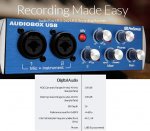Eleanor Fudd said:
Are those converters "pro" quality, or would professional studios typically have converters of higher quality again?
RME has a good reputation. Lots of other competitors.
CoolCat said:
yeah not sure what the converters will show, whats that test Ethan did?
Rane something into the Mackie through "butthorns". I think the files may have gotten mixed up on that one.
ecc83 said:
There have been very few really well constructed comparisons between converters that I am aware of in the last 10 years or so.
Designing a proper test with the right controls and interpreting the results effectively is an art form itself. The results will always be subjective.
garww said:
You can judge each section of the interface, but you can't do that without the interface to test ; ) If the box is big enough, you might be able to get some discrete op-amps in there - like Burson, etc..
I think the biggest difference between converters is going to come down to
- the clock with regard to stability and jitter
- the analog components of the converter
I'm not sure how much of an effect you can expect form clock performance. Even modest converters can perform well.
The analog components will make a difference in "character" (distortion) and phase coherence. It still remains subjective. Mastering grade converters are generally super expensive, clean and accurate with a lot of headroom at the expense of having any character at all. Probably not something you'd want to track and mix with, but very well suited to mastering. You'd be hearing the source, not the converter.
Tracking and mixing is more about the sound than how accurate it is. If you're using a Radar or Lynx or whatever you like, it might be imparting subtle amounts of colour (for lack of a better term like "euphonic distortion" or something) that makes things sound pleasing and easy to work with. The coloration is probably not something you'd want at mastering, so different converters for different processes.
On the "economy" end of the scale, the biggest difference is most likely the analog design of the converter. Similar to preamps. Less headroom. Likely to distort if pushed hard enough, but not likely to be "euphonic". You can still get decent results with these things if the gain staging is conservative enough to avoid distortion.
The thing is, the converter is one of the last things in the chain so any tiny, subjective differences you might expect are going to be influenced by everything else. You might get better results by changing guitar strings or experimenting with mic placement. Finding the weak link in the chain is key. It might be monitors, the room, mics, preamps or something else. If all that stuff is solid, it might be worth considering a converter upgrade. Until then, something else in the chain might yield a bigger improvement. If you don't have the monitoring chain to support it, you might not hear any difference between converters.
Chili said:
If you're looking to trade up and have a $1000 budget, look at the UAD Apollo.
I'm not familiar with these, but it seems that the big difference is with the ability to handle the UAD plugins and offload the DSP power to run them. Price point is still within reach given the added functions, but it goes up if you want to add more plugins.


